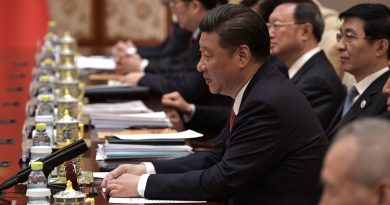U.S. and Iran Feud Over Attacks on Saudi Oil Facilities
Axel Sontgerath
Staff Writer
Over the weekend of September 13, eighteen drones and seven cruise missiles attacked two Saudi oil facilities in Abqaiq and Khurais. According to the Associated Press, President Trump stated on Monday that it “looks like” Iran was behind the explosive attack, with several other members of the Trump administration reinforcing the statement. The President stated earlier that he was “locked and loaded” to deal with the issue but has since rolled back and is now pursuing more peaceful options and consultation with Saudi Arabia.
Secretary of State Mike Pompeo immediately blamed Iran, and on Wednesday called the attack an “act of war.” He has since softened his stance, and told reporters on Friday that, “[the United States] would like a peaceful solution,” The New York Times reports. Kelly Craft, new U.S. Ambassador to the United Nations, and Defense Secretary Mark Esper have also condemned the attacks and have blamed Iran.
On Friday, the United States imposed further sanctions on the Iranian national bank, according to The Wall Street Journal. Treasury Secretary Steven Mnuchin said the new sanctions cut off the last remaining source of funds for Iran. Aside from the sanctions, the White House is currently pursuing an international coalition to exert pressure on Iran through the U.N.
The Saudi government released U.S. satellite images of the damaged facilities on Monday. They called the attacks an “unprecedented act of aggression and sabotage.” The images showed that the attackers had detailed knowledge of which tanks and machinery to hit to cripple production. Joe Bermudez, an expert at the Center for Strategic and International Studies, stated to AP that, “the satellite images can’t show you where the attack originated from,” but added that they “could indicate that someone planned a sophisticated, coordinated attack that really impacted the production of oil at the facility.”
Saudi Arabia also displayed missile and drone wreckage in a news conference and cited other evidence that the raid was “unquestionably sponsored by Iran.” Saudi officials also stated at the same news conference that the cruise missiles used have a range of 700 kilometers (435 miles), and could not have been fired from Yemen, as the Iranians have so far claimed.
The Saudi government has invited the United Nations and other international experts to help investigate, showing that the kingdom is in no rush to retaliate, AP reports. As of 10 p.m. on September 19, Secretary-General Antonio Guterres stated that U.N. experts have already left for Saudi Arabia to investigate attacks on key Saudi oil installations. Iran has denied all claims of involvement, citing Houthi rebels and Yemeni citizens as the primary culprits.
Iranian officials are not happy with the American response, stating that they “currently don’t see any sign from the Americans which has honesty in it.” According to The New York Times, Iranian Foreign Minister Mohammad Javad Zarif constituted any military attack on Iran by the United States or Saudi Arabia as an act of “all out war.” Mr. Zarif added that all allegations are “based on deception.” He also added that he is “making a very serious statement that [Iran] doesn’t want war… But [Iran] won’t blink to defend its territory.”
The economic effects of the strike were large at first but calmed after Saudi Arabia was able to repair some of the oil facilities. The attacks shut down half of Saudi Arabia’s oil production, knocking out around 5.7 million barrels a day, half of Saudi Arabia’s global daily exports and more than 5 percent of the world’s daily crude oil production.
This type of attack and response fits with a strategy Iran has followed for months in its escalating confrontation with the Trump administration. Iran seeks to inflict the same pain it is feeling from suffocating economic sanctions on its adversaries. This, in turn, has threatened the ability of Saudi Arabia and other American allies in the Persian Gulf to sell oil and it may drive up international oil prices in the months before Trump seeks re-election.
This pushback from Iran is coming fresh off a summer of heightened tensions between the large Middle Eastern nation and the United States. The tension fueled by President Trump’s decision to tear up the Iran Nuclear Deal in 2015 and re-impose sanctions has pushed Iran’s economy into a freefall.
As to the possibility of a physical conflict, a quote from an anonymous Iranian strategist to the New York Times sends a chilling message to the parties involved. “If the U.S strikes Iran, the flames of war in the Persian Gulf will burn you all.”

